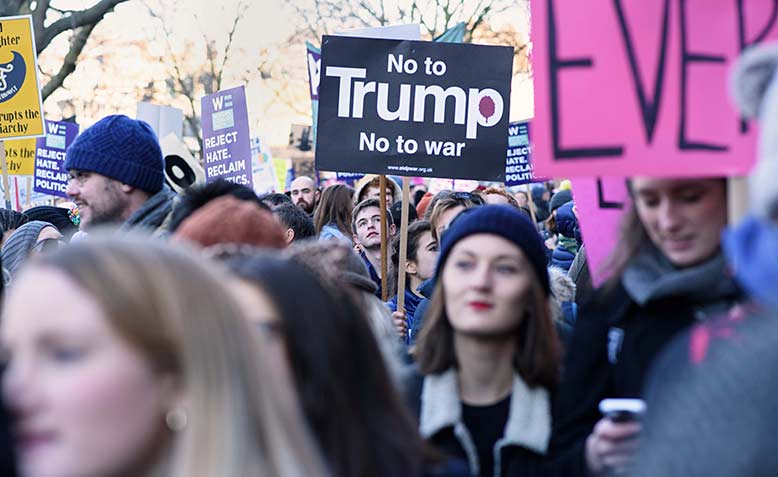 Women's march on London, 2017. Photo: Jim Aindow
Women's march on London, 2017. Photo: Jim Aindow
How should socialists orient to mass protests?
On Saturday, January 21st I went down to the Women’s March on Washington: Toronto. Like most people, I did not really know what to expect. As soon as I got on the subway near my house, roughly ten stops away, I was surrounded by a packed crowd of would-be protesters holding anti-Trump placards. This was a sure sign the rally was going to be big.
The estimates for the Toronto march ranged from 15,000 – to 60,000. In all honesty it was hard to tell when you were in the thick of it, but by recent Toronto protest standards, it was big (I can think of only three Toronto protests in the last 20 years that are even comparable: the Tamil protest in 2009, the G20 rally in 2010 and the Iraq war demos in 2003).
As soon as I arrived I found the Fight for $15 and Fairness table. They had been busy handing out leaflets and signing people up to their petition. They had, because they are very good organizers, already made special leaflets and placards that linked the issues of raising the minimum wage and paid sick days to the struggle for gender justice and women’s equality.
I joined many others from the campaign in distributing the campaign material in the crowd and we got a great reception. Surprisingly, I noticed few other campaigns or organizations doing the same.
When I got home I saw the reports that the Women’s March demos across the United States and around the world were much larger than expected. I also noticed some debate about the meaning, potential and political impact of the large Women’s Marches.
This got me thinking about how people like me, socialists, should orient to large marches and movements. I don’t think what I have to say is particularly original or revelatory. But as we are faced with the prospect of entering a period where we will see more large protests, it is important we are clear about how we should and can relate to them.
1Large protests that are relatively spontaneous (responding to an event, not the product of a campaign) will always have very mixed content, from speakers at the front, to people’s signs etc. It should not be a surprise that these large protests attract lots of people with liberal or “mainstream” ideas and world views.
2People’s practice almost always moves far ahead of their ideas and how they articulate them. This gap is what is important for socialists. When people are protesting against Trump, for instance, they are open to ideas and debates about how best to do this and what other issues relate to that fight.
3Socialists should be trying to talk to people and recruit them to campaigns that they can relate to (for us it was, do you hate Trump and what he stands for? Then help us fight for a $15 minimum wage, paid sick days and equal pay). The key is to get people active, help them build their politics through practice, give them the tools and confidence to fight. We all need avenues to learn and sharpen our analysis, and the best way to do that is through collective struggle.
4Mass movements and protests ebb and flow. The goal should be to draw as many people as possible into active struggle against oppression and class exploitation. What that looks like exactly should be dictated by local conditions.
Struggles and campaigns are where people learn and can be won to the idea of socialist politics and the need for socialist organization. People by and large simply do not move from the current set of mixed political ideas to socialist/radical politics in one fell swoop, but rather through a series of successive approximations.
5We should have a clear head about what the possibilities and limits are of moments like these and what is required in the next phase of struggle. Being overly optimistic or overly pessimistic is pointless. Large demos against Trump with loose demands won’t win anything, but they are a cauldron of discontent in which we should be mixing it up.
The job of socialists is to weave the various issues and struggles together into a coherent political vision that explains the world and how we can change it. Our goal is to help point the way forward and to win the largest layer of people we can over into active struggle.
6If we aren’t involved in campaigns or political organizations oriented towards the larger working class we can’t actually effectively intervene in moments like this. No single socialist, no matter how smart or skilled, can make a practical political intervention. Individuals’ opinions are not a substitute for political practice, at moments like these, we require collective political practice in order to orient ourselves and seize opportunities and avoid pitfalls.
7The internet is not real life. For all the debates, the left practice on the ground is actually easy to figure out if you are part of campaigning. For instance, all the debates about how to orient to the protest were solved by the Fight for $15 and Fairness organizers almost immediately – materials were produced, people were organized to go out spread our message and recruit people to join our campaign.
Ultimately our politics should be focused on talking to new people, people with mixed ideas, people to our right, not endless debating people to our left. Our political debates on the left should be settled by whose practice is actually working.
8The left should develop clarity about orienting to mass movements and protests because if we think the liberal centre is collapsing we are bound to see much more of them.

